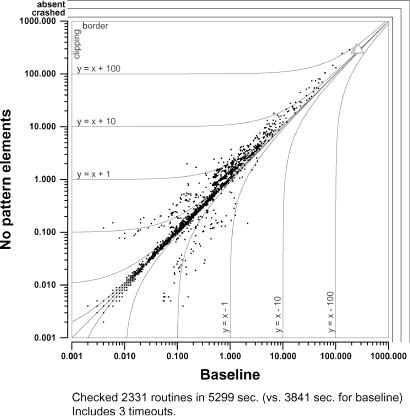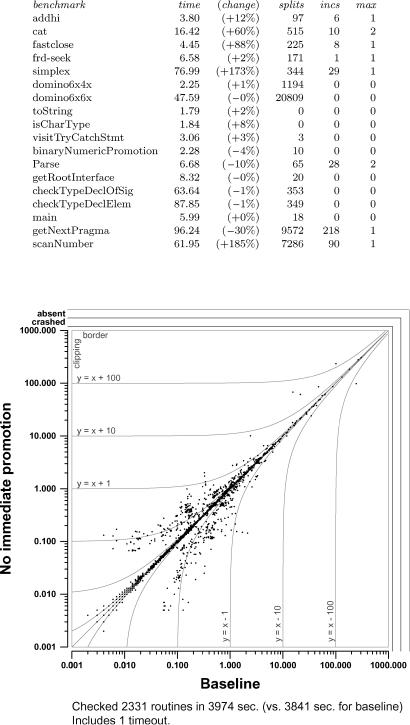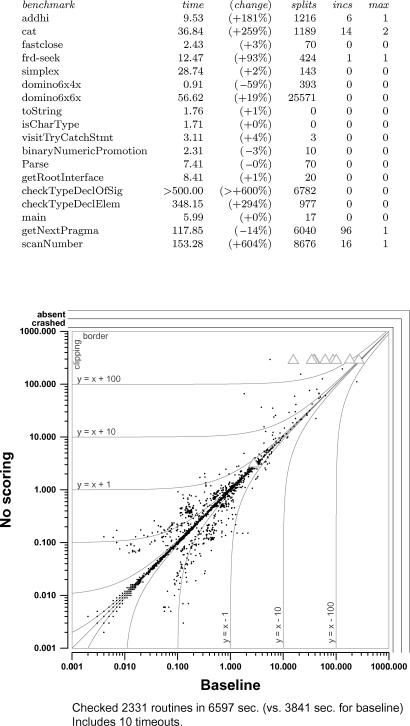
p365-detlefs(хижа)
.pdf
Simplify: A Theorem Prover for Program Checking |
455 |
FIG. 9. Performance data for the small test suite with the pattern-element optimization disabled.
triangle near the middle of the figure is an anomaly that we do not understand: somehow turning off the mod-time optimization caused a proof to fail. In spite of this embarrassing mystery, the evidence in favor of the mod-time optimization is compelling, both for improving average performance and for steering clear of the worst case.
9.4.THE PATTERN-ELEMENT OPTIMIZATION. As described in Section 5.4.3, Simplify uses the pattern-element optimization to avoid fruitlessly trying to match rules if no recent change to the E-graph can possibly have created new instances.
As shown in Figures 9 and 10, the results on the examples from program checking are similar to those for the mod-time optimization—either improvements (sometimes quite significant) or insignificant slowdowns. The domino examples suggest that the cost is significantly smaller than that for updating mod-times.
The mod-time and pattern-element optimizations have a common purpose— saving matching effort that cannot possibly yield new matches. Figure 11 shows what happens when both are disabled. About three quarters of the savings from the two optimizations overlap, but the remaining savings is significant enough to justify doing both.
9.5.SUBSUMPTION. As described in Section 3.2, Simplify uses the subsumption heuristic, which asserts the negation of a literal upon backtracking from the case in which the literal was asserted. By default, Simplify uses subsumption by setting the status (§3.2) of the literal to false, and also, if it is a literal of the E-graph (except for nonbinary distinctions (§2)) or of an ordinary theory, denying it by a call to the appropriate assert method. By setting an environment variable, we can cause Simplify to set the status of the literal, but not to assert its negation. Figure 12 shows that the performance data for this option are inconclusive. The data on the front end test suite (not shown) are also inconclusive.
9.6.MERIT PROMOTION. As described in Section 5.2.1, Simplify uses merit promotion: When a Pop reduces the matching depth, Simplify promotes the highest scoring (§3.6) clause from the deeper matching level to the shallower level.

456 |
D. DETLEFS ET AL. |
FIG. 10. Effect of disabling the pattern-element optimization on the front-end test suite.
Figures 13 and 14 show the effect of turning off merit promotion. In our small test suite, one method (cat) times out, and two methods (getNextPragma and scanNumber) show noticeable improvements. On the front-end suite, turning off promotion causes two methods to time out and improves the performance in a way that counts on only one (which in fact is getNextPragma). The total time increases by about ten percent.
We remark without presenting details that promote set size limits of 2, 10 (the default), and a million (effectively infinite for our examples) are practically indistinguishable on our test suites.
9.7. IMMEDIATE PROMOTION. As described in Section 5.2.1, Simplify allows a matching rule to be designated for immediate promotion, in which case any instance of the rule is added to the current clause set instead of the pending clause set. In our test suites, the only immediately promoted rule is the nonunit select-of-store axiom (§2).
Figure 15 shows the effect of turning off immediate promotion on the small test suite. Immediate promotion provides a significant improvement on four test cases (cat, fastclose, simplex, and scanNumber), but a significant degradation on another (getNextPragma). The front-end test suite strengthens the case for the heuristic: Looking at the upper right corner of Figure 16 which is where the expensive verification conditions are, outliers above the diagonal clearly outnumber

Simplify: A Theorem Prover for Program Checking |
457 |
FIG. 11. Effect of disabling both the mod-time and pattern-element optimizations on the front-end test suite.
FIG. 12. Performance data for the small test suite with subsumption disabled.

458 |
D. DETLEFS ET AL. |
FIG. 13. Performance data for the small test suite with merit promotion disabled.
FIG. 14. Effect of disabling merit promotion on the front-end test suite.

Simplify: A Theorem Prover for Program Checking |
459 |
FIG. 15. Performance data for the small test suite with immediate promotion disabled.
FIG. 16. Effect of disabling immediate promotion on the front-end test suite.

460 |
D. DETLEFS ET AL. |
FIG. 17. Performance data for the small test suite with the activation heuristic disabled (so that triggers are matched against all E-nodes, rather than active E-nodes only).
outliers below the diagonal. Furthermore, the heuristic reduces the total time on the front end test suit by about five percent.
We remark without presenting details that consecutive immediately promoted split limits of 1, 2, 10 (the default), and a million (effectively infinite for our examples) are practically indistinguishable on our test suites.
9.8.ACTIVATION. As described in Section 5.2, Simplify uses the activation heuristic, which sets the active bit in those E-nodes that represent subterms of atomic formulas (§2) that are currently asserted or denied, and restricts the matcher (§5.1) to find only those instances of matching rule triggers that lie in the active portion of the E-graph.
Figure 17 shows that the effect of turning off activation on the small test suite is very bad. Five of the tests time out, two crash with probable matching loops (see Section 5.1), several other tests slow down significantly, and only one (checkTypeDeclOfSig) shows a significant improvement. In the front-end test suite (not shown) thirty-two methods time out, eighteen crash with probable matching loops, and the cloud of dots vote decisively for the optimization.
9.9.SCORING. As described in Section 3.6, Simplify uses a scoring heuristic, which favors case splits that have recently produced contradictions. Figures 18 and 19 show that scoring is effective.
Of the problems in the small test suite derived from program checking, scoring helps significantly on six and hurts on none. The results are mixed for the two domino problems.
On the front-end test suite, scoring had mixed effects on cheap problems, but was very helpful for expensive problems. With scoring off ten problems time out, and the total time increases by sixty percent.
9.10.E-GRAPH TESTS. As described in Section 4.6, Simplify uses E-graph tests, which checks the E-graph data structure, instead of the literal status fields only, when refining clauses. Figures 20 and 21 show that the E-graph test is effective, especially on expensive problems.

Simplify: A Theorem Prover for Program Checking |
461 |
FIG. 18. Performance data for the small test suite with scoring disabled.
FIG. 19. Effect of disabling scoring on the front-end test suite.

462 |
D. DETLEFS ET AL. |
FIG. 20. Performance data for the small test suite with the E-graph status test disabled.
FIG. 21. Effect of disabling the E-graph status test on the front-end test suite.

Simplify: A Theorem Prover for Program Checking |
463 |
FIG. 22. Performance data for the small test suite with distinction classes disabled (so that an n-ary distinction is translated into n2 binary distinctions).
9.11.DISTINCTION CLASSES. As described in Section 7.1, Simplify uses distinction classes, a space-efficient technique for asserting the pairwise distinctness of a set of more than two items. Interestingly enough, Figures 22 and 23 show the performance effects of distinction classes are negligible. We do not know what causes the strange asymmetrical pattern of dots in the front end test suite.
9.12.LABELS. As described in Section 6.2, Simplify uses labels to aid in error localization. We have done two experiments to measure the cost of labels, one to compare labels versus no error localization at all, and one to compare labels versus error variables.
The first experiment demonstrates that Simplify proves valid labeled verification conditions essentially as fast as it proves valid unlabeled verification conditions. This experiment was performed on the small test suite by setting a switch that causes Simplify to discard labels at an early phase. Figure 24 shows the results: there were no significant time differences on any of the examples.
The second experiment compares labels with the alternative “error variable” technique described in Section 6.2. It was performed on the small test suite by manually editing the examples to replace labels with error variables. Figure 25 shows the results: in all but one of the examples where the difference was significant, labels were faster than error variables.
9.13.SIMPLEX REDUNDANCY FILTERING. As described in Section 8.3.1, Simplify uses Simplex redundancy filtering to avoid processing certain trivially redundant arithmetic assertions. Figure 26 shows the effect of disabling this optimization on the front-end test suite. The aggregate effect of the optimization is an improvement of about 10 percent.
The remaining subsections of this section do not evaluate particular options, but present measurements that we have made that seem to be worth recording.
9.14.FINGERPRINTING MATCHES. As described in Section 5.2, Simplify maintains a table of fingerprints of matches, which is used to filter out redundant matches, that is, matches that have already been instantiated on the current path (§3.1). The

464 |
D. DETLEFS ET AL. |
FIG. 23. Effect of disabling distinction classes on the front-end test suite.
FIG. 24. Performance data for the small test suite with labels ignored.
